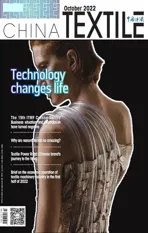Phase change materials regulate temperature fluctuations like air conditioners
2022-11-15ByZhaoXinhua
By Zhao Xinhua

Phase change materials (PCMs) are theo—retically able to change state at nearly a constant temperature and therefore to store a large quan—tity of energy to regulate temperature fluctua—tions.The thermal energy storage in PCMs occurs when they change from solid to liquid and the energy dissipates when they change back from liquid to solid.The different phases of PCMs have distinctly different physical properties such as electrical conductivity,optical reflectivity,mass density,or thermal conductivity.PCMs keep people comfortable through the absorbing,stor—age,and releasing of the heat.Without PCMs,the thermal insulation capacity of clothing depends on the thickness and density of the fabric.In—corporating microcapsules of PCMs into textile structures improves the thermal performance of the textiles.There are many thermal benefits of treating textile structures with PCM microcapsules such as cooling,insula—tion,and the thermoregulating effect.PCMs are applicable in blankets and comforters,bed sheets,dress shirts,T—shirts,undergarments,swaddling blankets,and other textile products.
There are several factors that need to be considered when selecting a PCM.An ideal PCM will have high heat of fusion,high thermal conductivity,high specific heat and density,longterm reliability during repeated cycling,and dependable freezing behavior.Paraffin waxes are the most common PCMs,which can be microencapsulated and then either integrated into fiber or used as a coating in textiles that have a high heat of fusion per unit weight,large melting point selection,and a low thermal conductivity;pro—vide dependable cycling;are noncorrosive;and are chemically inert.
The PCM microcapsules are also applied to a fibrous substrate using a binder (e.g.,acrylic resin).All common coating processes such as knife over roll,knife over air,screen—printing,gravure printing,and dip coating may be adapted to apply the PCM microcapsules dispersed throughout a polymer binder to fabric.The conventional pad-mangle systems are also suitable for applying PCM microcapsules to fabrics.The formulation containing PCMs can also be applied to the fabric by the direct nozzle spray technique.
Outlast fiber
Outlast fiber,which appeared in the European and American markets in recent years,is one of the represen—tative products.The key of its technology is to put PCM microcapsules inside the fiber,and realize automatic tem—perature adjustment through spinning or finishing.
Outlast was originally developed as a material for spacesuits used by NASA.It keeps the skin's surface tem—perature at a comfortable 33°C at all times.Now Outlast fibers are more used in lingerie,knitwear,skirts,shirts and other clothing.Outlast reduces sweat by 34% compared to regular fabric,making you stay cool even on hot summer days,according to experimental data.
In order to determine a sufficient PCM quantity,the heat generated by the human body has to be taken into account,carrying out strenuous activities under which the active wear garments are worn.The heat generated by the body needs to be entirely released through the garment layers into the environment.The necessary PCM quantity is determined according to the amount of heat,which should be absorbed by the PCMs to keep the heat balance equalized.It is mostly not necessary to put PCMs in all parts of the garment.Applying PCM microcapsules to the areas that provide problems from a thermal stand—point and thermoregulating the heat flux through these areas are often enough.It is also advisable to use differ—ent PCM microcapsules in different quantities in distinct garment locations.
In addition,Outlast can also be used for sheets,blan—kets and bedding,and maintain a constant temperature during sleep,and allow the temperature and humidity to be just right,thus optimizing the temperature and humid—ity to make you have a good sleep.
Used in four seasons
PCMs are used in winter and summer clothing notonly in high—quality outerwear and footwear but also in the underwear,socks,gloves,helmets,and bedding of world—wide brand leaders.Seat covers in cars and chairs in offices can consist of PCMs.In outdoor apparels,PCMs are being used in a variety of items such as smart jackets,vests,men’s and women’s hats and rainwear,outdoor active—wear jackets and jacket lining,golf shoes,trekking shoes,ski and snowboard gloves,ski boots,and earmuffs.In pro—tective garments,PCMs are being used in a variety of items such as firefighter protective clothing,bulletproof fabrics,space suits,sailor suits,and so on.
A new generation of military fabrics features PCMs that are able to absorb,store,and release excess body heat when the body needs it,resulting in less sweating and freezing,while the microclimate of the skin is influenced in a positive way and efficiency and performance are en—hanced.In the medical textile field,a blanket with PCMs can be useful for gently and controllably reheating hypo—thermia patients.Also,using PCMs in bed covers regulates the micro climate of the patient.In domestic textiles,blinds and curtains with PCMs can be used for reduction of the heat flux through windows.
One example of the practical application of PCM smart textile is the cooling vest (TST Sweden Ab).This is a comfort garment developed to prevent elevated body temperatures in people who work in hot environments or use extreme physical exertion.The cooling effect is obtained from the vest’s 21 PCM elements containing Glauber’s salt,which starts absorbing heat at a particular temperature (28°C).Heat absorption from the body or from an external source continues until the elements have melted.After use,the cooling vest has to be charged at room temperature (24°C)or lower.When all the PCMs are solidified,the cooling vest is ready for further use.
Although the current focus of smart textile design—ers is mostly on fashion and appearance of the clothing,from the perspective of the human physiology-clothingenvironment system and thermal physiology,the safety and protection engineers and physiologists emphasize functions in terms of developing functional and protective clothing by using phase change materials (PCMs).
